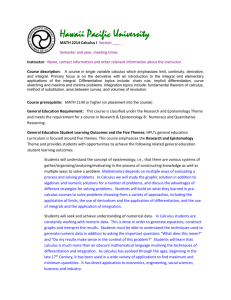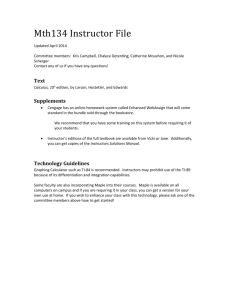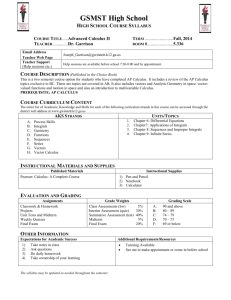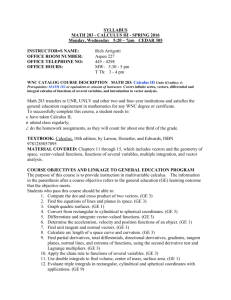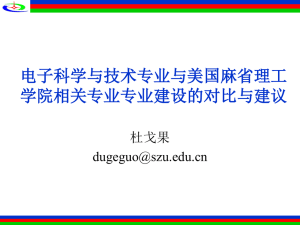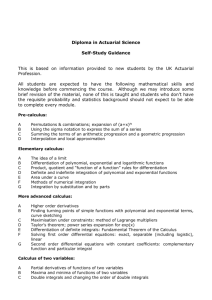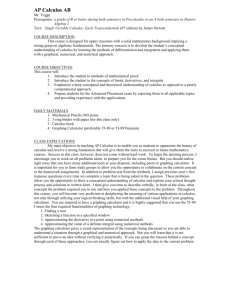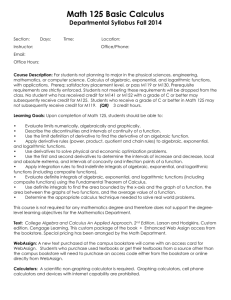Hawaii Pacific University
advertisement
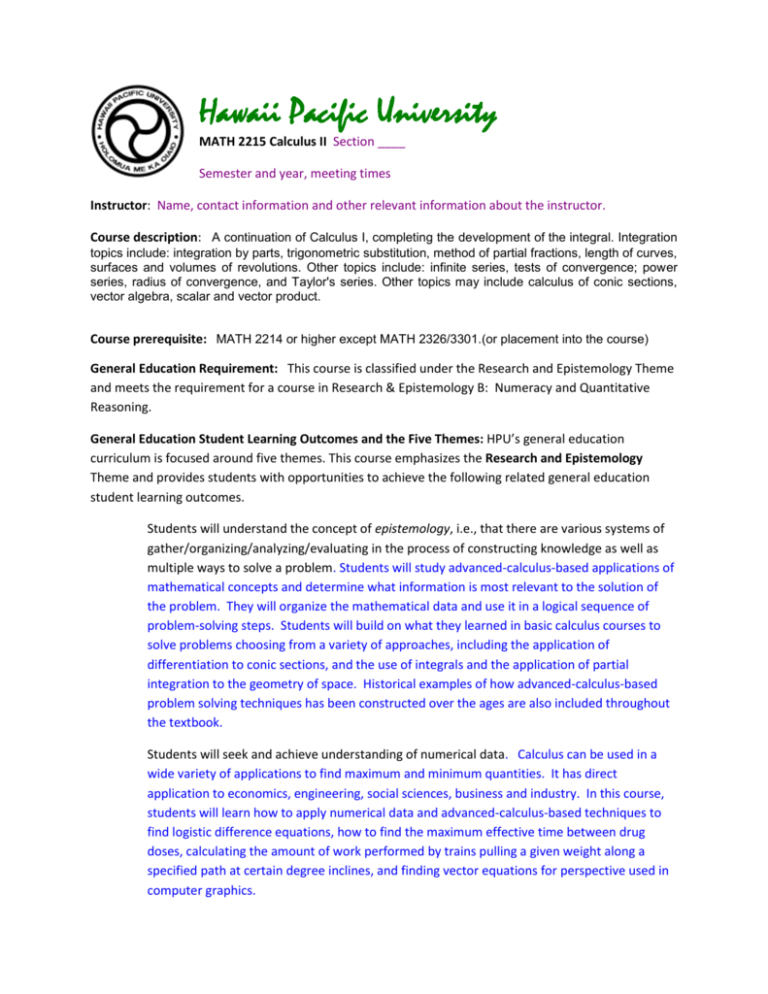
Hawaii Pacific University MATH 2215 Calculus II Section ____ Semester and year, meeting times Instructor: Name, contact information and other relevant information about the instructor. Course description: A continuation of Calculus I, completing the development of the integral. Integration topics include: integration by parts, trigonometric substitution, method of partial fractions, length of curves, surfaces and volumes of revolutions. Other topics include: infinite series, tests of convergence; power series, radius of convergence, and Taylor's series. Other topics may include calculus of conic sections, vector algebra, scalar and vector product. Course prerequisite: MATH 2214 or higher except MATH 2326/3301.(or placement into the course) General Education Requirement: This course is classified under the Research and Epistemology Theme and meets the requirement for a course in Research & Epistemology B: Numeracy and Quantitative Reasoning. General Education Student Learning Outcomes and the Five Themes: HPU’s general education curriculum is focused around five themes. This course emphasizes the Research and Epistemology Theme and provides students with opportunities to achieve the following related general education student learning outcomes. Students will understand the concept of epistemology, i.e., that there are various systems of gather/organizing/analyzing/evaluating in the process of constructing knowledge as well as multiple ways to solve a problem. Students will study advanced-calculus-based applications of mathematical concepts and determine what information is most relevant to the solution of the problem. They will organize the mathematical data and use it in a logical sequence of problem-solving steps. Students will build on what they learned in basic calculus courses to solve problems choosing from a variety of approaches, including the application of differentiation to conic sections, and the use of integrals and the application of partial integration to the geometry of space. Historical examples of how advanced-calculus-based problem solving techniques has been constructed over the ages are also included throughout the textbook. Students will seek and achieve understanding of numerical data. Calculus can be used in a wide variety of applications to find maximum and minimum quantities. It has direct application to economics, engineering, social sciences, business and industry. In this course, students will learn how to apply numerical data and advanced-calculus-based techniques to find logistic difference equations, how to find the maximum effective time between drug doses, calculating the amount of work performed by trains pulling a given weight along a specified path at certain degree inclines, and finding vector equations for perspective used in computer graphics. Students will recognize the multiple interpretations numerical data permit and ways that they can be manipulated. In this calculus class, students will find that numerical data related to advanced calculus based functions and operations can be interpreted in different ways. For example, data presented might indicate that a cylinder generated by moving a straight line along a given curve can have different interpretations depending upon whether the generating curve is along a given planar or along a circle. Another example is the visualization of surfaces in space. Since graphs can be drawn in different planes and rotated, the data might have to be entered in standard form for one application, while entered in parametric form for another application of the same data. Series may be expressed as recursive functions or explicit formulas. Students must be able to go from one to the other. Students will utilize methods and technologies appropriate to the discipline to investigate research questions, generate predictions, test hypotheses and/or solve problems. Students will use verbal (written or oral), numerical (data table), symbolic (mathematical formula), and graphical representations of functions to solve problems. In the lessons provided, problem-solving techniques are presented that employ the use of a graphing calculator. One example of the appropriate use of a graphing calculator involves determining the limit of a power series, using the trapezoidal rule and / or Simpson’s Rule numeric integration, exploring the graphs of complex exponential, logarithmic or trigonometric functions. Graphing is often used to confirm and illustrate calculus methods. Note: Purple text shows places where specific course information must be filled in. Red text contains explanatory notes to the instructor which should be deleted before using the syllabus. Blue explanations above should be rephrased by the individual instructor if necessary to reflect the specific approach in that section of the course. Course specific outcomes below are an example and may also be rephrased or modified by the instructor. Student Learning Outcomes for MATH 2215 Calculus II Upon the successful completion of this course, students should be able to: 1. Calculate the Riemann sum for a given function, partition and collection of evaluation points. 2. Describe a definite integral as: the limit of a Riemann sum, the area under a curve, the distance traveled by a moving object, and a total accumulation. 3. Describe the meaning of the integral of a function. 4. Determine the integrals of polynomial, trigonometric, exponential and logarithmic functions. 5. Approximate the numerical values of definite integrals using the Trapezoidal Rule and Simpson’s Rule. 6. State and paraphrase the Fundamental Theorem of Calculus. 7. Apply the ideas of definite integrals to solve problems of: determining area, finding the volumes of solids of revolutions, work, centers of mass, and other assorted applications. 8. Recognize separable differential equations and to use integration to solve separable initial value problems. 9. Solve problems of exponential growth and decay and to understand the meanings and limitations of those solutions. 10. Differentiate the inverse trigonometric functions and identify when to use them with integrals. 11. To describe the meaning of an improper integral and to evaluate some classes of improper integrals. 12. To apply the techniques of integration by parts, substitution, partial fractions and tables of anti-derivatives to evaluate integrals. 13. Determine whether a sequence or series converges or diverges. 14. Determine the sum of convergent geometric series. 15. Find the nth Taylor polynomial at a specified center for a function. 16. Find, differentiate and integrate a power series for a function. For the rest of these required syllabus items see the details in the faculty handbook. Delete this note once the syllabus is complete. For online courses there are some additional requirements given at this link. Texts List textbooks with ISBN’s and include this language as well All textbook information (pricing, ISBN #, and e-books) for this course can be found on the HPU Bookstore website: hpu.edu/bookstore. If you have any questions regarding textbooks, please contact the HPU Bookstore at: Phone: 808-544-9347 Or e-mail: jyokota@hpu.edu mmiyahira@hpu.edu Assignments and mode of evaluation Summary of important dates and deadlines (if the schedule is a separate document and due dates are not given with the description of the assignments). Class rules and policies (including regarding attendance, late work and academic dishonesty) Schedule of events (may be attached separately)

